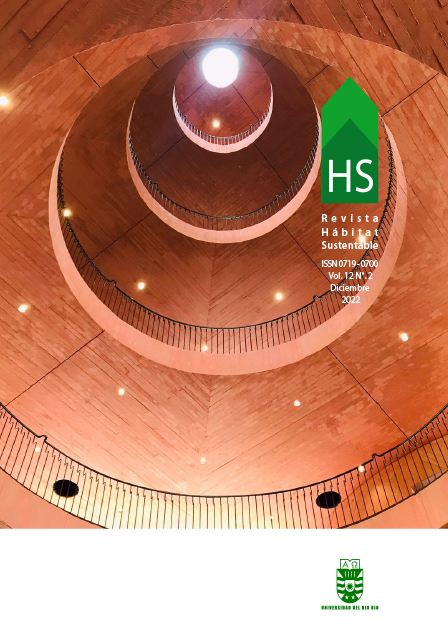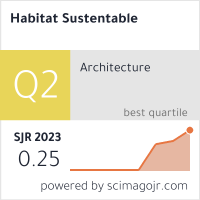Análisis de las propiedades físicas y mecánicas del residuo de caucho de neumático como reemplazo parcial del agregado fino en el hormigón
DOI:
https://doi.org/10.22320/07190700.2022.12.02.04Palabras clave:
materiales de construcción, desarrollo sostenible, medio ambiente.Resumen
El objetivo del presente estudio es evaluar las propiedades físicas y mecánicas del hormigón con residuos de caucho de neumático (RCN) como sustituto parcial a la arena, considerando materiales locales de la ciudad de Cochabamba, Bolivia, a fin de promover una economía circular. Para ello, se sustituyó la arena por RCN (en volumen) en cuatro porcentajes: 0% (referencia), 5%, 10% y 20%, evaluando sus propiedades mecánicas (resistencia a la compresión, tracción y flexión) y físicas (masa específica, absorción de agua e índice de vacíos). Los resultados indican que existe una tendencia a la disminución a mayor porcentaje de RCN, tanto para la resistencia mecánica como para las propiedades físicas, a excepción de la mezcla con 5% de RCN, la cual presentó resultados comparables al hormigón con arena natural. El RCN puede ser utilizado en la elaboración local de hormigón hasta en un 5% sin comprometer sus propiedades mecánicas y físicas, y brinda además un enfoque sostenible.
Descargas
Citas
ABD-ELAAL, E. S., ARABY, S., MILLS, J. E., YOUSSF, O., ROYCHAND, R., MA, X., ZHUGE, Y. Y GRAVINA, R. J. (2019). Novel approach to improve crumb rubber concrete strength using thermal treatment. Construction and Building Materials, 229. DOI: https://doi.org/10.1016/j.conbuildmat.2019.116901
ABDELMONEM, A., EL-FEKY, M., NASR, E. Y KOHAIL, M. (2019). Performance of high strength concrete containing recycled rubber. Construction and Building Materials, 227. DOI: https://doi.org/10.1016/j.conbuildmat.2019.08.041
ABNT (2011). NBR 7222: Concreto e argamassa — Determinação da resistência à tração por compressão diametral de corpos de prova cilíndricos.
ALWESABI, E., BAKAR, B., ALSHAIKH, I. Y AKIL, H. (2020). Experimental investigation on mechanical properties of plain and rubberised concretes with steel–polypropylene hybrid fibre. Construction and Building Materials, 233. DOI: https://doi.org/10.1016/j.conbuildmat.2019.117194
ASLANI, F., MA, G., WAN, D. L. Y. Y MUSELIN, G. (2018). Development of high-performance self-compacting concrete using waste recycled concrete aggregates and rubber granules. Journal of Cleaner Production, 182, 553-566. https://doi.org/10.1016/j.jclepro.2018.02.074
Asociación Española de Normalización (2020). UNE-EN 12350-2: Ensayos de hormigón fresco. Parte 2: Ensayo de asentamiento. UNE: Madrid, España.
ASTM (2015a). ASTM C127-15: Standard Test Method for Relative Density (Specific Gravity) and Absorption of Coarse Aggregate. DOI: https://doi.org/10.1520/C0127-15
ASTM (2015b). ASTM C128-15: Standard Test Method for Relative Density (Specific Gravity) and Absorption of Fine Aggregate. DOI: https://doi.org/10.1520/C0128-15
ASTM (2016). ASTM C293/C293M-16: Standard Test Method for Flexural Strength of Concrete (Using Simple Beam With Center-Point Loading). DOI: https://doi.org/10.1520/C0293_C0293M-16
ASTM (2020). ASTM C136/C136M-19: Standard Test Method for Sieve Analysis of Fine and Coarse Aggregates. DOI: https://doi.org/10.1520/C0136_C0136M-19
ASTM (2021). ASTM C642-21. Standard Test Method for Density, Absorption, and Voids in Hardened Concrete. DOI: https://doi.org/10.1520/C0642-21
BISHT, K. Y RAMANA, P. (2017). Evaluation of mechanical and durability properties of crumb rubber concrete. Construction and building materials, 155, 811-817. DOI: https://doi.org/10.1016/j.conbuildmat.2017.08.131
CEN (2010). CEN/TS 14243:10. Materials produced from end of life tyres - Specification of categories based on their dimension(s) and impurities and methods for determining their dimension(s) and impurities. Recuperado de: https://standards.iteh.ai/catalog/standards/cen/713de38b-eb7a-4a4e-b1b1-fdf10f56a5f8/cen-ts-14243-2010
CZAJCZYŃSKA, D., KRZYŻYŃSKA, R., JOUHARA, H. Y SPENCER, N. (2017). Use of pyrolytic gas from waste tire as a fuel: A review. Energy, 134, 1121-1131. DOI: https://doi.org/10.1016/j.energy.2017.05.042
DERAKHSHAN, Z., GHANEIAN, M., MAHVI, A., CONTI, G., FARAMARZIAN, M., DEHGHANI, M. Y FERRANTE, M. (2017). A new recycling technique for the waste tires reuse. Environmental research, 158, 462-469. DOI: https://doi.org/10.1016/j.envres.2017.07.003
EISA, A. S., ELSHAZLI, M. T. Y NAWAR, M. T. (2020). Experimental investigation on the effect of using crumb rubber and steel fibers on the structural behavior of reinforced concrete beams. Construction and Building Materials, 252. DOI: https://doi.org/10.1016/j.conbuildmat.2020.119078
ELCHALAKANI, M. (2015). High strength rubberized concrete containing silica fume for the construction of sustainable road side barriers. Structures, 1, 20-38. DOI: https://doi.org/10.1016/j.istruc.2014.06.001
GESOĞLU, M., GÜNEYISI, E., KHOSHNAW, G. E İPEK, S. (2014). Investigating properties of pervious concretes containing waste tire rubbers. Construction and Building Materials, 63, 206-213. DOI: https://doi.org/10.1016/j.conbuildmat.2014.04.046
GRAVINA, R. J. Y XIE, T. (2022). Toward the development of sustainable concrete with Crumb Rubber: Design-oriented Models, Life-Cycle-Assessment and a site application. Construction and Building Materials, 315. DOI: https://doi.org/10.1016/j.conbuildmat.2021.125565
GURUNANDAN, M., PHALGUN, M., RAGHAVENDRA, T. Y UDAYASHANKAR, B. (2019). Mechanical and damping properties of rubberized concrete containing polyester fibers. Journal of Materials in Civil Engineering, 31(2), 1-10. DOI: https://doi.org/10.1061/(ASCE)MT.1943-5533.0002614
HILAL, N. (2017). Hardened properties of self-compacting concrete with different crumb rubber size and content. International Journal of Sustainable Built Environment, 6(1), 191-206. DOI: https://doi.org/10.1016/j.ijsbe.2017.03.001
HOSSEIN, A. H., AZARIJAFARI, H. Y KHOSHNAZAR, R. (2022). The role of performance metrics in comparative LCA of concrete mixtures incorporating solid wastes: A critical review and guideline proposal. Waste Management, 140, 40-54. DOI: https://doi.org/10.1016/j.wasman.2022.01.010
HUANG, W., HUANG, X., XING, Q. Y ZHOU, Z. (2020). Strength reduction factor of crumb rubber as fine aggregate replacement in concrete. Journal of Building Engineering, 32. DOI: https://doi.org/10.1016/j.jobe.2020.101346
IBNORCA (1987). CBH 87: Estructuras de hormigón. Norma Boliviana. Hormigón Armado. Instituto Boliviano de Normalización y Calidad (IBNORCA). Recuperado de: https://cadecocruz.org.bo/UserFiles/File/CBH_87.pdf
KADHIM, A. A. Y KADHIM, H. M. (2021). Experimental investigation of rubberized reinforced concrete continuous deep beams. Journal of King Saud University-Engineering Sciences [en prensa]. DOI: https://doi.org/10.1016/j.jksues.2021.03.001
KAISH, A. B. M. A., ODIMEGWU, T. C., ZAKARIA, I. Y ABOOD, M. M. (2021). Effects of different industrial waste materials as partial replacement of fine aggregate on strength and microstructure properties of concrete. Journal of Building Engineering, 35. DOI: https://doi.org/10.1016/j.jobe.2020.102092
KANGAVAR, M. E., LOKUGE, W., MANALO, A., KARUNASENA, W. Y FRIGIONE, M. (2022). Investigation on the properties of concrete with recycled polyethylene terephthalate (PET) granules as fine aggregate replacement. Case Studies in Construction Materials, 16. DOI: https://doi.org/10.1016/j.cscm.2022.e00934
KARUNARATHNA, S., LINFORTH, S., KASHANI, A., LIU, X. Y NGO, T. (2021). Effect of recycled rubber aggregate size on fracture and other mechanical properties of structural concrete. Journal of Cleaner Production, 314. DOI: https://doi.org/10.1016/j.jclepro.2021.128230
LETELIER, V., BUSTAMANTE, M., MUÑOZ, P., RIVAS, S. Y ORTEGA, J. M. (2021). Evaluation of mortars with combined use of fine recycled aggregates and waste crumb rubber. Journal of Building Engineering, 43. DOI: https://doi.org/10.1016/j.jobe.2021.103226
LI, Y., ZHANG, X., WANG, R. Y LEI, Y. (2019). Performance enhancement of rubberised concrete via surface modification of rubber: A review. Construction and Building Materials, 227. DOI: https://doi.org/10.1016/j.conbuildmat.2019.116691
MARQUES, B., ANTONIO, J., ALMEIDA, J., TADEU, A., DE BRITO, J., DIAS, S., PEDRO, F. Y SENA, J. D. (2020). Vibro-acoustic behaviour of polymer-based composite materials produced with rice husk and recycled rubber granules. Construction and Building Materials, 264. DOI: https://doi.org/10.1016/j.conbuildmat.2020.120221
MOUSTAFA, A. Y ELGAWADY, M. (2015). Mechanical properties of high strength concrete with scrap tire rubber. Construction and Building Materials, 93, 249-256. DOI: https://doi.org/10.1016/j.conbuildmat.2015.05.115
NAJIM, K. B. Y HALL, M. R. (2013). Crumb rubber aggregate coatings/pre-treatments and their effects on interfacial bonding, air entrapment and fracture toughness in self-compacting rubberised concrete (SCRC). Materials and structures, 46(12), 2029-2043. DOI: https://doi.org/10.1617/s11527-013-0034-4
OLIVEIRA NETO, G. C. D., CHAVES, L. E. C., PINTO, L. F. R., SANTANA, J. C. C., AMORIM, M. P. C. Y RODRIGUES, M. J. F. (2019). Economic, environmental and social benefits of adoption of pyrolysis process of tires: A feasible and ecofriendly mode to reduce the impacts of scrap tires in Brazil. Sustainability, 11(7). DOI: https://doi.org/10.3390/su11072076
PACHECO-TORGAL, F., DING, Y. Y JALALI, S. (2012). Properties and durability of concrete containing polymeric wastes (tyre rubber and polyethylene terephthalate bottles): An overview. Construction and Building Materials, 30, 714-724. DOI: https://doi.org/10.1016/j.conbuildmat.2011.11.047
PHAM, N. P., TOUMI, A. Y TURATSINZE, A. (2019). Effect of an enhanced rubber-cement matrix interface on freeze-thaw resistance of the cement-based composite. Construction and Building Materials, 207, 528-534. DOI: https://doi.org/10.1016/j.conbuildmat.2019.02.147
RASHID, K., YAZDANBAKHSH, A. Y REHMAN, M. (2019). Sustainable selection of the concrete incorporating recycled tire aggregate to be used as medium to low strength material. Journal of Cleaner Production, 224, 396-410. DOI: https://doi.org/10.1016/j.jclepro.2019.03.197
REN, F., MO, J., WANG, Q. Y HO, J. C. M. (2022). Crumb rubber as partial replacement for fine aggregate in concrete: An overview. Construction and Building Materials, 343. DOI: https://doi.org/10.1016/j.conbuildmat.2022.128049
ROSS, D. E. (2020). Use of waste tyres in a circular economy. Waste Management & Research, 38(1), 1-3. DOI: https://doi.org/10.1177/0734242X19895697
SALONI, PARVEEN, PHAM, T., LIM, Y. Y MALEKZADEH, M. (2021). Effect of pre-treatment methods of crumb rubber on strength, permeability and acid attack resistance of rubberised geopolymer concrete. Journal of Building Engineering, 41. DOI: https://doi.org/10.1016/j.jobe.2021.102448
SHAHJALAL, M., ISLAM, K., RAHMAN, J., AHMED, K. S., KARIM, M. R. Y BILLAH, A. M. (2021). Flexural response of fiber reinforced concrete beams with waste tires rubber and recycled aggregate. Journal of Cleaner Production, 278. DOI: https://doi.org/10.1016/j.jclepro.2020.123842
SILVA, L., MOUTA, J., COSTA, M. Y GOMES, L. (2019). Concreto com borracha de recauchutagem de pneu para uso em pavimentação de baixo tráfego. Matéria (Rio de Janeiro), 24. DOI: https://doi.org/10.1590/S1517-707620190002.0676
SU, H., YANG, J., LING, T., GHATAORA, G. Y DIRAR, S. (2015). Properties of concrete prepared with waste tyre rubber particles of uniform and varying sizes. Journal of Cleaner Production, 91, 288-296. https://doi.org/10.1016/j.jclepro.2014.12.022
SWISSCONTACT (2020). Reciclaje de llantas, productos verdes con valor agregado. Swisscontact. Recuperado de: https://www.swisscontact.org/es/noticias/reciclaje-de-llantas-productos-verdes-con-valor-agregado
SYMEONIDES, D., LOIZIA, P. Y ZORPAS, A. (2019). Tire waste management system in Cyprus in the framework of circular economy strategy. Environmental Science and Pollution Research, 26(35), 35445-35460. DOI: https://doi.org/10.1007/s11356-019-05131-z
TAHA, M., EL-DIEB, A., ABD EL-WAHAB, M. Y ABDEL-HAMEED, M. (2008). Mechanical, fracture, and microstructural investigations of rubber concrete. Journal of materials in civil engineering, 20(10), 640-649. DOI: https://doi.org/10.1061/(ASCE)0899-1561(2008)20:10(640)
The Freedonia Group (2012). Global demand for aggregates to exceed 48 billion metric tons in 2015. Concrete construction. Recuperado de: https://www.concreteconstruction.net/business/global-demand-for-construction-aggregates-to-exceed-48-billion-metric-tons-in-2015_o
THOMAS, B. Y GUPTA, R. (2015). Long term behaviour of cement concrete containing discarded tire rubber. Journal of Cleaner Production, 102, 78-87. DOI: https://doi.org/10.1016/j.jclepro.2015.04.072
TRUDSØ, L. L., NIELSEN, M. B., HANSEN, S. F., SYBERG, K., KAMPMANN, K., KHAN, F. R. Y PALMQVIST, A. (2022). The need for environmental regulation of tires: Challenges and recommendations. Environmental Pollution, 311. DOI: https://doi.org/10.1016/j.envpol.2022.119974
VARGAS, J. (2017). Llantas en botaderos, una bomba de tiempo. Los tiempos. Recuperado de: https://www.lostiempos.com/actualidad/local/20170620/llantas-botaderos-bomba-tiempo
WU, Y. F., KAZMI, S. M. S., MUNIR, M. J., ZHOU, Y. Y XING, F. (2020). Effect of compression casting method on the compressive strength, elastic modulus and microstructure of rubber concrete. Journal of Cleaner Production, 264. DOI: https://doi.org/10.1016/j.jclepro.2020.121746
YOUSSF, O., MILLS, J. E. Y HASSANLI, R. (2016). Assessment of the mechanical performance of crumb rubber concrete. Construction and Building Materials, 125, 175-183. DOI: https://doi.org/10.1016/j.conbuildmat.2016.08.040
ZHANG, W., GONG, S. Y ZHANG, J. (2018). Effect of rubber particles and steel fibers on frost resistance of roller compacted concrete in potassium acetate solution. Construction and Building Materials, 187, 752-759. DOI: https://doi.org/10.1016/j.conbuildmat.2018.07.244
Descargas
Publicado
Cómo citar
Número
Sección
Licencia
Derechos de autor 2022 Luz Adriana Fernandez-Torrez, Joaquin Humberto Aquino-Rocha, Nahúm Gamalier Cayo-Chileno

Esta obra está bajo una licencia internacional Creative Commons Atribución-CompartirIgual 4.0.
El contenido de los artículos que se publican en cada número de Hábitat Sustentable, es responsabilidad exclusiva de los autores y no representan necesariamente el pensamiento ni comprometen la opinión de la Universidad del Bío-Bío.
Los autores/as conservarán sus derechos de autor y garantizarán a la revista el derecho de primera publicación de su obra, el cuál estará simultáneamente sujeto a la Licencia de Reconocimiento de Creative Commons CC BY-SA que permite a otros compartir-copiar, transformar o crear nuevo material a partir de esta obra con fines no comerciales, siempre y cuando se reconozcan la autoría y la primera publicación en esta revista, y sus nuevas creaciones estén bajo una licencia con los mismos términos.











 Programa de Información Científica/Concurso Fondos de Publicación de Revistas Científicas 2018/ Proyecto Mejoramiento de Visibilidad de Revistas UBB (Código:FP180007)
Programa de Información Científica/Concurso Fondos de Publicación de Revistas Científicas 2018/ Proyecto Mejoramiento de Visibilidad de Revistas UBB (Código:FP180007) 





